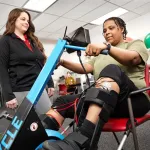(Press-News.org)
An international team of researchers led by the Strong Correlation Quantum Transport Laboratory of the RIKEN Center for Emergent Matter Science (CEMS) has demonstrated, in a world’s first, an ideal Weyl semimetal, marking a breakthrough in a decade-old problem of quantum materials.
Weyl fermions arise as collective quantum excitations of electrons in crystals. They are predicted to show exotic electromagnetic properties, attracting intense worldwide interest. However, despite the careful study of thousands of crystals, most Weyl materials to date exhibit electrical conduction governed overwhelmingly by undesired, trivial electrons, obscuring the Weyl fermions. At last, researchers have synthesized a material hosting a single pair of Weyl fermions, and no irrelevant electronic states.
The work, published this week in Nature, arose from a collaboration over four years between CEMS, the RIKEN Interdisciplinary Theoretical and Mathematical Sciences Program (iTHEMS), the Quantum-Phase Electronics Center (QPEC) of the University of Tokyo, the Institute for Materials Research of Tohoku University, and Nanyang Technological University in Singapore. The researchers engineered a Weyl semimetal from a topological semiconductor, revisiting a strategy which was first theoretically proposed in 2011, but then abandoned and largely forgotten by the community.
Semiconductors have a small ‘energy gap’ which allows them to be switched between insulating and conducting states, forming the basis for the commercial transistor. Semimetals can be viewed as a kind of extreme limit of a semiconductor with zero ‘energy gap’, right at the threshold between insulator and metal. This extreme case remains exceedingly rare in real materials. Perhaps the best-known example is graphene, which has found uses in moiré physics and flexible electronics.
The topological semiconductor used in the current study is bismuth telluride, Bi2Te3. The researchers adjusted the chemical composition of the material in a highly controlled way, substituting chromium for bismuth, creating (Cr,Bi)2Te3. According to Ryota Watanabe, Ph.D. student and co-first author of the study, “We were intrigued at first by the large anomalous Hall effect (AHE) in (Cr,Bi)2Te3, which signaled new physics beyond that of topological semiconductors.” Ching-Kai Chi of iTHEMS and co-author of the work, noted that, “unlike previous Weyl materials, the uniquely simple electronic structure of (Cr,Bi)2Te3 enabled us to quantitatively explain our experiments using a precise theory. We could then trace the large AHE back to emergent Weyl fermions.”
First author Ilya Belopolski of CEMS, recalls that the finding came as a shock to both himself and colleagues around the world. “Different communities had already established the key theoretical and experimental insights needed to synthesize this Weyl semimetal. But it looks like we were not communicating with one another, so we missed out on this discovery. In retrospect, it should have come about nearly a decade earlier.”
As for why this insight ultimately emerged at RIKEN, Belopolski credits the unique combination of brilliant researchers, generous research funding and dynamic intellectual atmosphere of CEMS. “There were many talented research groups in the United States, China and across Europe working on related topics for many years. The reason this discovery took place here is likely because of the highly creative and collaborative environment at RIKEN.”
One potential application is in terahertz (THz) devices. Semiconductors can only absorb photons with energy greater than their energy gap, which typically rules out the THz frequency range. According to Yuki Sato, postdoctoral researcher and co-author of the work, “Unlike semiconductors, semimetals have a vanishing energy gap, so they can absorb low frequency light, down to THz frequencies. We are currently interested in applying our ideal Weyl semimetal to the generation and detection of THz light.”
The team further anticipates research into high-performance sensors, low-power electronics, and novel optoelectronics devices. Postdoctoral researcher Lixuan Tai, who joined the Strong Correlation Quantum Transport Laboratory as this work was nearing publication, expressed excitement about the near-term research enabled by this new quantum phase of matter. “It makes this a particularly exciting time to join this research team, since having an actual Weyl semimetal available to us after all these years will surely enable many exciting breakthroughs.”
END
A study led by scientists at Rutgers University-New Brunswick has shown that specialized cells involved in how the body responds to insulin are activated in the brain after exercise, suggesting that physical activity may directly improve brain function.
A study, published in Aging Cell, a journal focused on the biology of aging, indicates that therapies targeting this insulin action may be developed to offset or even prevent dementia progression.
“We believe this work is important because it suggests exercise may work to improve cognition and memory by improving the abilities of insulin to act on the brain,” ...
Ultrawide-bandgap semiconductors—such as diamond—are promising for next-generation electronics due to a larger energy gap between the valence and conduction bands, allowing them to handle higher voltages, operate at higher frequencies, and provide greater efficiency compared to traditional materials like silicon. However, their unique properties make it challenging to probe and understand how charge and heat move on nanometer-to-micron scales. Visible light has a very limited ability to probe nanoscale properties, and moreover, it is not absorbed ...
The first randomized control trial of the school-based intervention called Supporting Transition Resilience of Newcomer Groups (STRONG) shows significant reductions in depression, anxiety and behavior problems among refugee and immigrant students. The study, funded by the National Institute of Mental Health, was co-led by Ann & Robert H. Lurie Children’s Hospital of Chicago and Loyola University, in partnership with the Chicago Public Schools (CPS). Results were published in the American Journal of Community Psychology. Key findings are summarized ...
While entangled photons hold incredible promise for quantum computing and communications, they have a major inherent disadvantage. After one use, they simply disappear.
In a new study, Northwestern University physicists propose a new strategy to maintain communications in a constantly changing, unpredictable quantum network. By rebuilding these disappearing connections, the researchers found the network eventually settles into a stable — albeit different — state.
The key resides in adding a sufficient number of connections to ensure the ...
Major uncertainties remain about the impact of puberty blockers and gender affirming hormone therapy on children and young people with gender related distress (gender dysphoria), making it impossible to determine conclusively whether they help or harm, find two pooled data analyses of the available evidence, published online in the Archives of Disease in Childhood.
The findings echo those of the Hilary Cass review of gender identity services in the NHS, published last April. This concluded that the evidence for the use of puberty blockers and masculinising and feminising hormones for gender related distress—psychological distress caused by a mismatch between birth sex and gender ...
The prevalence of psychological distress caused by a mismatch between birth sex and gender identity, formally known as gender dysphoria, likely rose 50-fold nationwide between 2011 and 2021, suggests an analysis of primary care data in England and published online in Archives of Disease in Childhood.
This means the condition is still uncommon, with fewer than 1 in 200 17-18 year olds affected, but levels of concurrent anxiety, depression, and self harm are high. And access to timely care is a live issue for young people and their families, a second feedback study shows.
Most previously ...
Over the course of two decades, the lifespan of college graduates increased by 2.5 years to 84.2 years. If they were a country, their life expectancy would have ranked fourth globally.
By contrast, the lifespan of those who didn’t earn a high school diploma remained at 73.5 years. If they were a country, their life expectancy would have ranked 137th globally.
SEATTLE, Wash., Jan. 23, 2025 – Across more than 3,000 US counties, vast geographic differences with a widening gap were registered between the least and most educated, with a longer lifespan for those with a higher level of education. That’s ...
While climate change is likely to present significant challenges to agriculture in coming decades, it could also mean that crops such as chickpeas, soyabeans and oranges are widely grown across the UK, and home-produced hummus, tofu and marmalade are a common sight on our supermarket shelves by 2080.
A new study led by the UK Centre for Ecology & Hydrology (UKCEH) in collaboration with the University of East Anglia (UEA) predicts that future warmer temperatures in this country would be suitable for a variety ...
Researchers from The Ohio State University Wexner Medical Center and College of Medicine’s School of Health and Rehabilitation Sciences (HRS) recently published a study that found a link between impairments in physical function and hospital readmission risk among adults 50 years of age and older.
According to the Agency for Healthcare Research and Quality, 17% of Medicare beneficiaries in the United States returned to the hospital within 30 days of discharge between 2016 and 2020, posing burdens on healthcare systems and patients, alike.
“Physical function is a crucial indicator of underlying ...
DALLAS, January 23, 2025 — The American Heart Association, a global force changing the future of health for all, is championing student health and well-being by awarding financial grants to seven schools nationwide. These grants, provided through the Association’s Kids Heart Challenge™ and American Heart Challenge™ programs, enable schools to invest in resources like fitness equipment, water bottle filling stations, and educational tools to support healthier environments. By directly funding these in-school resources, the Association aims to foster healthy habits in youth to combat issues like childhood obesity—which, according to ...

